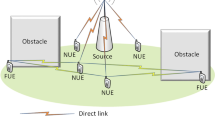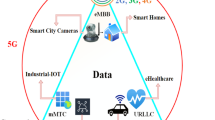Abstract
In order to obtain coding gain along with diversity gain, rotation code was applied to cooperative diversity employing decoded-and-forward cooperative protocol. Different from the same two symbols transmitted in conventional repetition-coded scheme, two different symbols were transmitted separately in two successive timeslots in the proposed rotation-coded cooperative diversity. In this way, constellation spread in the available two-dimensional signal space rather than on a single-dimensional line in repetition-coded scheme, which was supposed to be responsible for the additional coding gain. Under the proposed cooperative transmission model, upper bounds for the symbol-error-rate (SER) of cooperative diversity based on repetition code and rotation code were derived respectively. Both analytical and simulated results show that cooperative diversity based on rotation code can obtain an improved coding gain (by about 2 dB) than repetition-coded scheme without the expense of power or bandwidth.
Similar content being viewed by others
References
SENDONARIS A, ERKIP E, ZHANG B. User cooperation diversity. Part I: System description [J]. IEEE Transactions on Communications, 2003, 51(11): 1927–1938.
SENDONARIS A, ERKIP E, ZHANG B. User cooperation diversity. Part II: Implementation aspects and performance analysis [J]. IEEE Transactions on Communications, 2003, 51(11): 1939–1948.
LANEMAN J N, WORNELL G W. Distributed space-time-coded protocols for exploiting cooperative diversity in wireless networks [J]. IEEE Transactions on Information Theory, 2003, 49(10): 2415–2425.
NOSRATINIA A, HUNTER T E, HEDAYAT A. Cooperative communication in wireless networks [J]. IEEE Communications Magazine, 2004, 42(10): 74–80.
KRAMER G, GASTPAR M, GUPTA P. Cooperative strategies and capacity theorems for relay networks [J]. IEEE Transactions on Information Theory, 2005, 51(9): 3037–3063.
LARSSON E G, VOJCIC B R. Cooperative transmit diversity based on superposition modulation [J]. IEEE Communications Letters, 2005, 9(9): 778–780.
SU W, SADEK A K, LIU K J R. Cooperative communication protocols in wireless networks: Performance analysis and optimum power allocation [J]. Wireless Personal Communications, 2008, 44(2): 181–217.
LANEMAN J N, TSE D N C, WORNELL G W. Cooperative diversity in wireless networks: Efficient protocols and outage behavior [J]. IEEE Transactions on Information Theory, 2004, 50(12):3062–3080.
HUNTER T E, NOSRATINIA A. Cooperative diversity through coding [C]// Proceedings of the 2002 IEEE International Symposium on Information Theory. Lausanne, Switzerland: IEEE Information Theory Society, 2002: 220.
JANANI M, HEDAYAT A, HUNTER T E, NOSRATINIA A. Coded cooperation in wireless communications: Space-time transmission and iterative decoding [J]. IEEE Transactions on Signal Processing, 2004, 52(2): 362–371.
HUNTER T E, NOSRATINIA A. Diversity through coded cooperation [J]. IEEE Transactions on Information Theory, 2006, 52(2): 283–289.
TSE D, VISWANATH P. Fundamentals of wireless communication [M]. Cambridge: Cambridge University Press, 2005.
PROAKIS J G. Digital communications [M]. 4th ed. New York: McGraw-Hill, 2000.
SIMON M K, ALOUINI M-S. Digital communication over fading channels [M]. 2nd ed. New York: John Wiley & Sons, 2005.
KHORMUJI M N, LARSSON E G. Improving collaborative transmit diversity by using constellation rearrangement [C]// Proceedings of the IEEE WCNC 2007. Hong Kong, 2007: 803–807.
Author information
Authors and Affiliations
Corresponding author
Rights and permissions
About this article
Cite this article
Xiong, X., Ge, Jh., Li, J. et al. Cooperative diversity based on rotation code. J. Cent. South Univ. Technol. 16, 280–284 (2009). https://doi.org/10.1007/s11771-009-0048-9
Received:
Accepted:
Published:
Issue Date:
DOI: https://doi.org/10.1007/s11771-009-0048-9




